The Appeal of Indie Sleaze in 2023 (English Article)
I’m late to the party (pun intended), I know. However, it’s not that I haven’t been keeping up – in fact, I’ve been quite literally OBSESSED with indie sleaze for way too long at this point. If you’ve been actively following internet trends for the past year or two, you’ve probably heard this term being used in the context of fashion, revivals and even societal changes. Please bear with me though, because I’ve delved way too deep into it at this point (as my recent fourth rewatch of Skins UK might tell you). One of the somewhat questionable but also potentially positive side effects of my going through it? An unnecessarily extensive look into the indie sleaze aesthetic and all the lore surrounding it. Yup, I guess today could qualify as your lucky day (up for debate). Take a leap of faith and let me introduce you to the unpolished world of indie sleaze.
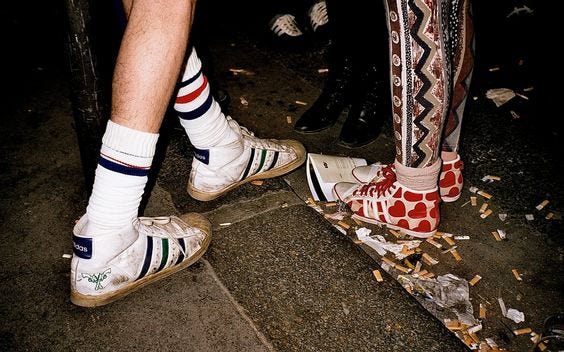
Before we begin, I’d like to take the time to share some personal memories. As a 24-year-old, I am definitely too young to have properly lived through the height of the sleazy phenomenon. However, I have distinct memories of it being the first trend I actively wanted to be a part of – largely due to my older sister, who, in my eyes, perfectly embodied the indie sleaze look. It’s funny how siblings can have such a big influence on you, right? As I grew older, particularly during my early teenage years, I felt like I was able to at least explore some of the nuances of this movement before it gradually transformed into more of the Tumblr Girl Trend of the mid-2010s (but I’ll save that story for another time). Looking back, I believe this era might have been what initially sparked my interest in fashion. And now, more than a decade later, here I am studying exactly that. It’s a true full-circle-moment for me.
Chapter One: The Basics
Now, what exactly is indie sleaze? I’m glad you asked. Let’s clarify something upfront: The aesthetic we currently associate with indie sleaze received its name retroactively. In other words, we only began using this specific term within the last few years. The style is often associated with underground art, music, and fashion. Through its combination of grit and provocation, indie sleaze served as a rebellious counterculture to the mainstream of the time. When you picture indie sleaze, you envision flashy party pictures capturing a wild and messy night out – in my opinion, that’s really the best way to describe both the scene back then and the appeal the aesthetic still holds. Although the youth-driven subculture wasn’t necessarily limited to particular places, it did flourish in certain hotspots and cities, with New York City, Los Angeles and London being the most notable examples.
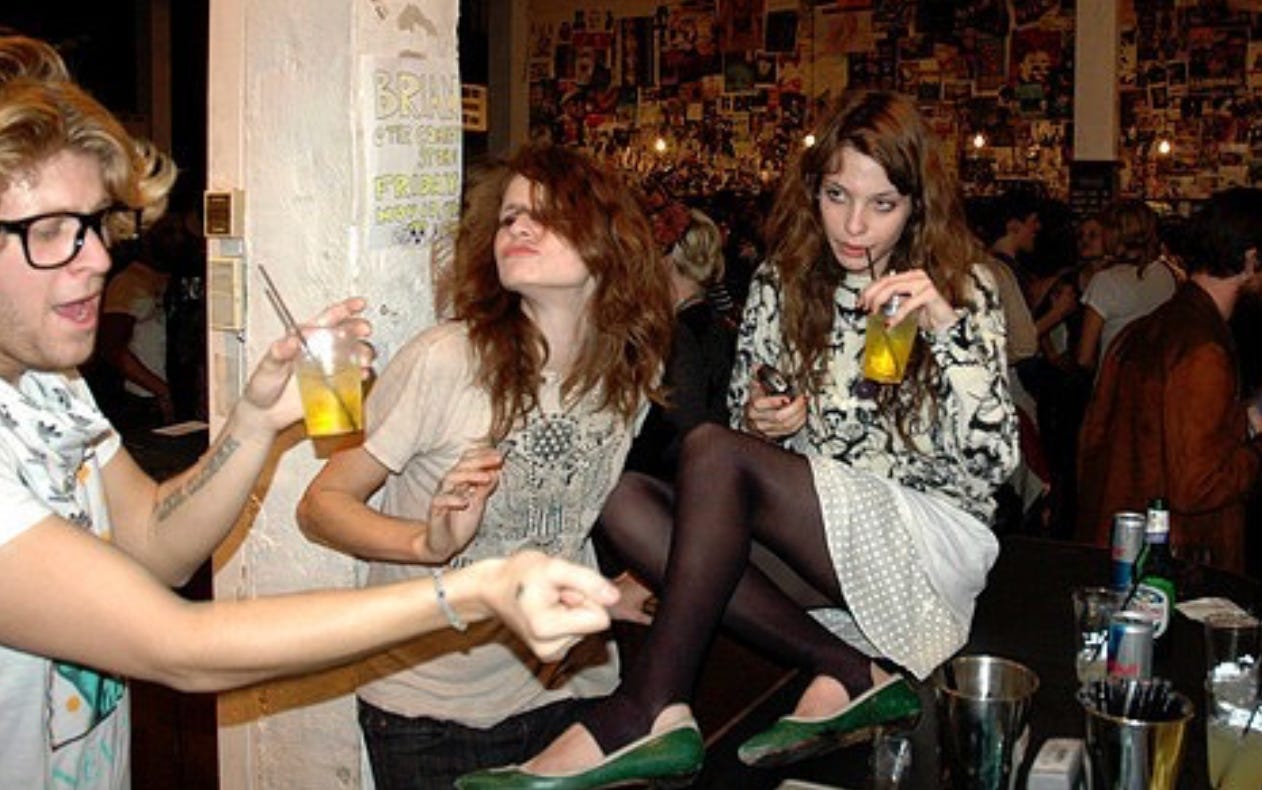
Chapter Two: The Historical Perspective
I’m sure the origin story of indie sleaze as a bygone phenomenon is pretty much common knowledge at this point, right? As a reminder: early suggestions of the trend started emerging in the mid-00s, however, the movement really took off in 2008 aka during the time of the Great Recession. Due to its provocative and carefree party vibe, indie sleaze was quickly labelled as the escapist, fun and maximalist response to the grim financial crisis of the time. Moreover, this period saw the rise of the internet and early forms of social media which served as platforms for self-expression and helped in spreading indie culture. With global sites like Myspace and Tumblr, as well as personal online blogs, independent artists could now reach a broader audience and connect directly with their audience. It’s generally believed that the trend’s popularity lasted roughly until 2012, although some sources argue that indie sleaze didn’t truly fade out until 2014. Personally, I tend to agree with the latter perspective, but it’s undeniable that the aesthetic already began evolving during those two years.
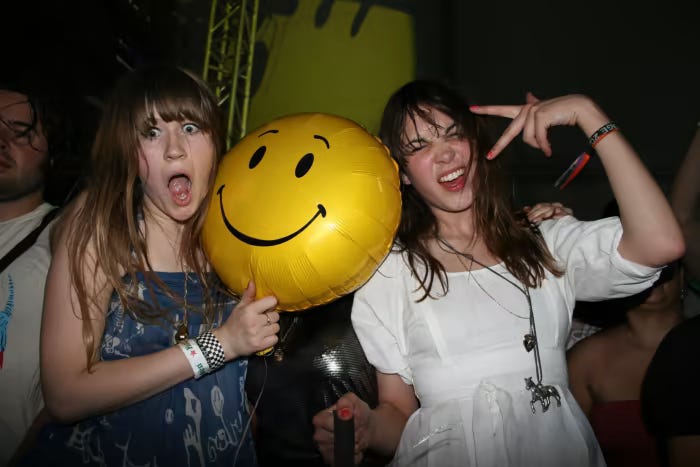
Chapter Three: The Main Characters
One thing’s for certain: the current appeal of the style owes a lot to the prominent figures appearing in all those gritty party pictures time and time again. Their fashion choices had a significant influence on an entire generation. Some key players include Alexa Chung, the Olsen twins, Cory Kennedy and many more. Apart from the “it girls”, artists themselves such as the Yeah Yeah Yeahs, the Strokes and Sky Ferreira also served as great sources of inspiration (but more on that in the next chapter). Most of the mentioned partygoers were captured in the distinctive photographs of Mark Hunter, also known as The Cobrasnake, and later shared on his website.
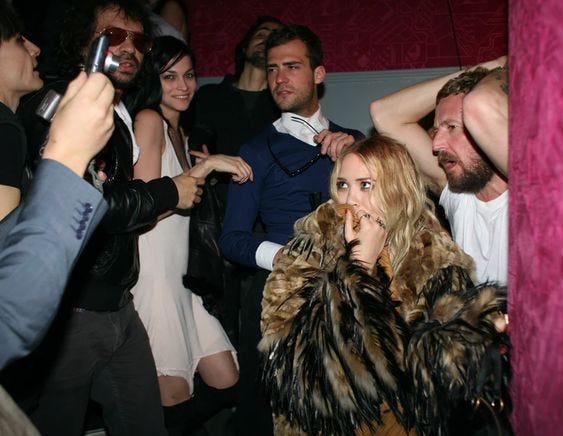
Suddenly, even individuals who weren’t already well-known gained access to a public platform and would go on to be admired by many. Particularly, Cory Kennedy, who was his girlfriend at the time, had a massive impact on the scene.
The fascination brought on by Hunter’s former girlfriend Cory Kennedy’s frequent appearances on his site turned her into a full-fledged sensation—she scored magazine covers and front-row seats at runway shows. “The Cobrasnake was this platform for discovering cool things, and then you start seeing this girl, who had amazing style and was sort of disheveled at the same time, but looked really effortless,” Hunter says. – W Magazine
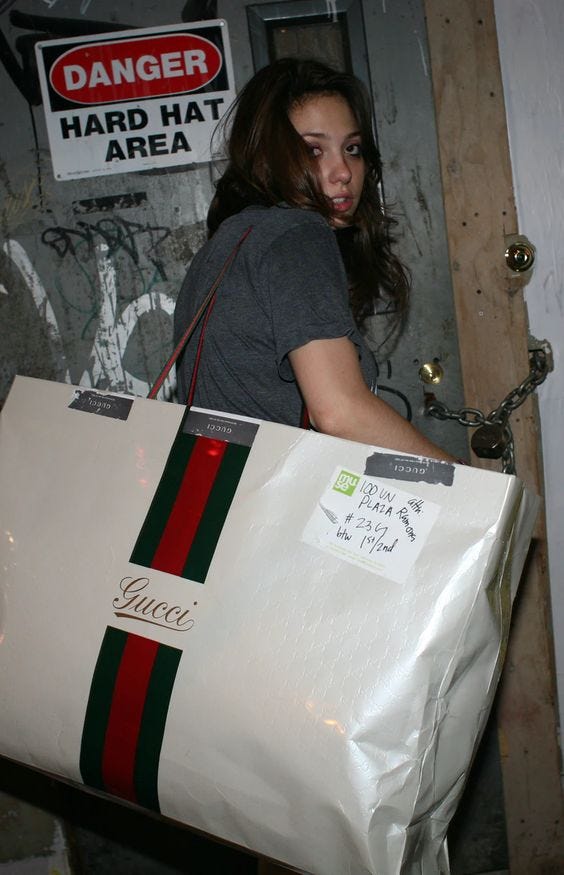
However, not every key figure was a “real” person per se. Specific TV series and films also influenced the culture in a significant way – Skins UK being a prime example. With its young and rebellious attitude, as well as its choices in fashion and music, the show perfectly depicted the unrefined elements of the era.
Chapter Four: The Music
Arguably the most important influence on the indie sleaze aesthetic as a whole? Music, obviously! (The visuals were party-centered, after all) Festivals played a vital role in boosting the popularity of artists associated with this genre.
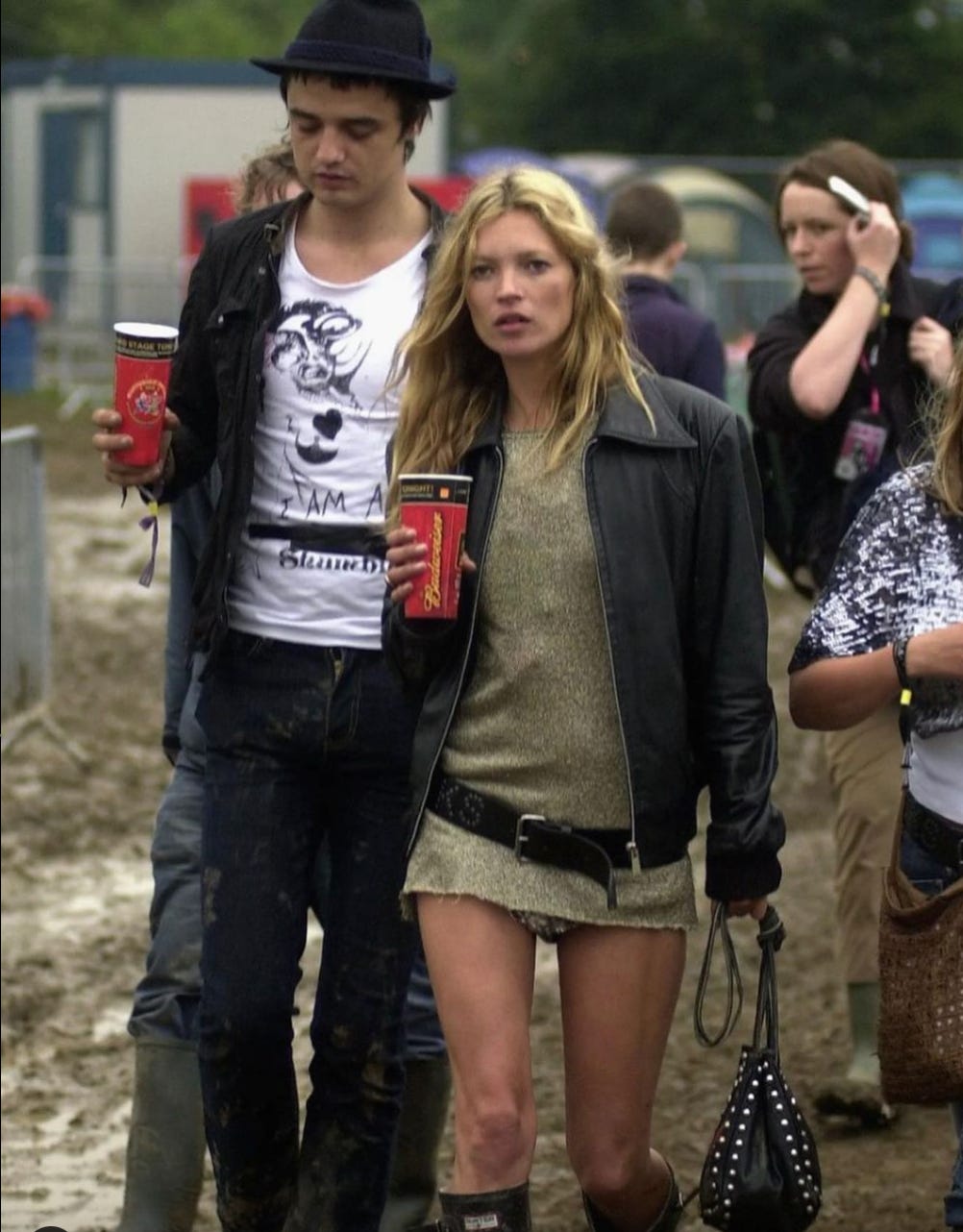
Numerous singers, bands and DJs contributed to music being the driving force of the countercultural movement. Realistically speaking, there were simply too many artists to cover them all and give them the recognition they deserve – I will try to include as many as I possibly can though. Personal favourites include The Strokes, Arctic Monkeys, Lana Del Rey, MGMT, Yeah Yeah Yeahs, Franz Ferdinand, Azealia Banks, Grimes, Santigold,… I could really go on forever, but I think you get the idea. The respective revivals of indie rock, electroclash and post-punk played a central role in shaping the indie sleaze aesthetic and I would like to argue that the music still holds up today.
Chapter Five: The Fashion
On to the most fun part of the era apart from its music: the fashion. One way to describe the style of the time? I’d say messy maximalism – but like, in an ironic way. The scene drew inspiration from various subcultures and decades, resulting in unique and often contradictory looks. Another big influence was the growing popularity of thrift stores and retro clothing. The 1970s, ‘80s and ‘90s served as major sources of inspiration for the indie sleaze aesthetic. Essentially, it can be characterised as a chaotic fusion of various trends that, on the one hand, might not seem like a good match, but, on the other hand, exuded an effortlessly cool vibe. Pieces which are commonly associated with the time include tights under shorts, disco leggings, ballet flats, ripped clothing, headbands, Jeffrey Campbell’s “Lita” boots, layered necklaces… oh, and anything from American Apparel (Dark Times). I do have a confession to make, however: I actually kind of love it – the chaos of it all, I mean. In fact, I’d argue that a lot of the pieces are already making their way back into fashion as we speak.
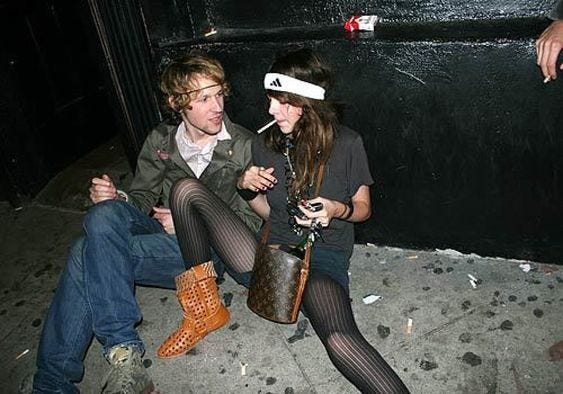
Chapter Six: The Attitude
If I had to sum up the prevailing attitude of that era in one word, it would be “YOLO” – I know, I know, the term might sound cringeworthy, but trust me, I’m right on this one. Given the shaky state of the world, the idea was to simply have fun while we still had the chance, because guess what? We’re all going to die eventually. Thus, the maximalist party aesthetic took over. I guess you could say that the goal was to be perfectly imperfect. It was all about the DIY/amateur/low-production vibes – especially in terms of photography. To illustrate this vibe, I’ll leave you with a video (horrible quality) that encapsulates it all: Skins, partying, great music, chaos and, oh yeah, drugs of course
Chapter Seven: The Controversy
As fun and carefree as the indie sleaze era might have looked, it undoubtedly had its problematic aspects as well. Heavy drug use, an unhealthy body image and missing diversity are just a few critical factors that instantly come to mind. Furthermore, big portions of the era were filled with misogyny. For instance, if you examine the iconic American Apparel advertisements (not showing the really bad ones), you’ll quickly notice how exploitative and downright problematic the aesthetic was. Did I find these American Apparel ads intriguing and cool at the time? Kind of. However, can I now view them critically and recognize the harm they perpetuated? Absolutely, without a doubt. To be fair, it’s probably easier to do so in retrospect and when you’re no longer in your formative years, but I digress. On top of that, several photographers who were once celebrated figures within the scene, like Terry Richardson, have since been exposed for inappropriate behaviour and sexual harassment. Turns out the guys who pride themselves in creating highly provocative photoshoots weren’t so great behind the scenes – who would have thought, huh? I’m not saying risqué imagery is inherently bad (in fact, my dedication to the aesthetic proves otherwise), but it’s something to keep in mind when reflecting on the influential people of that time period.
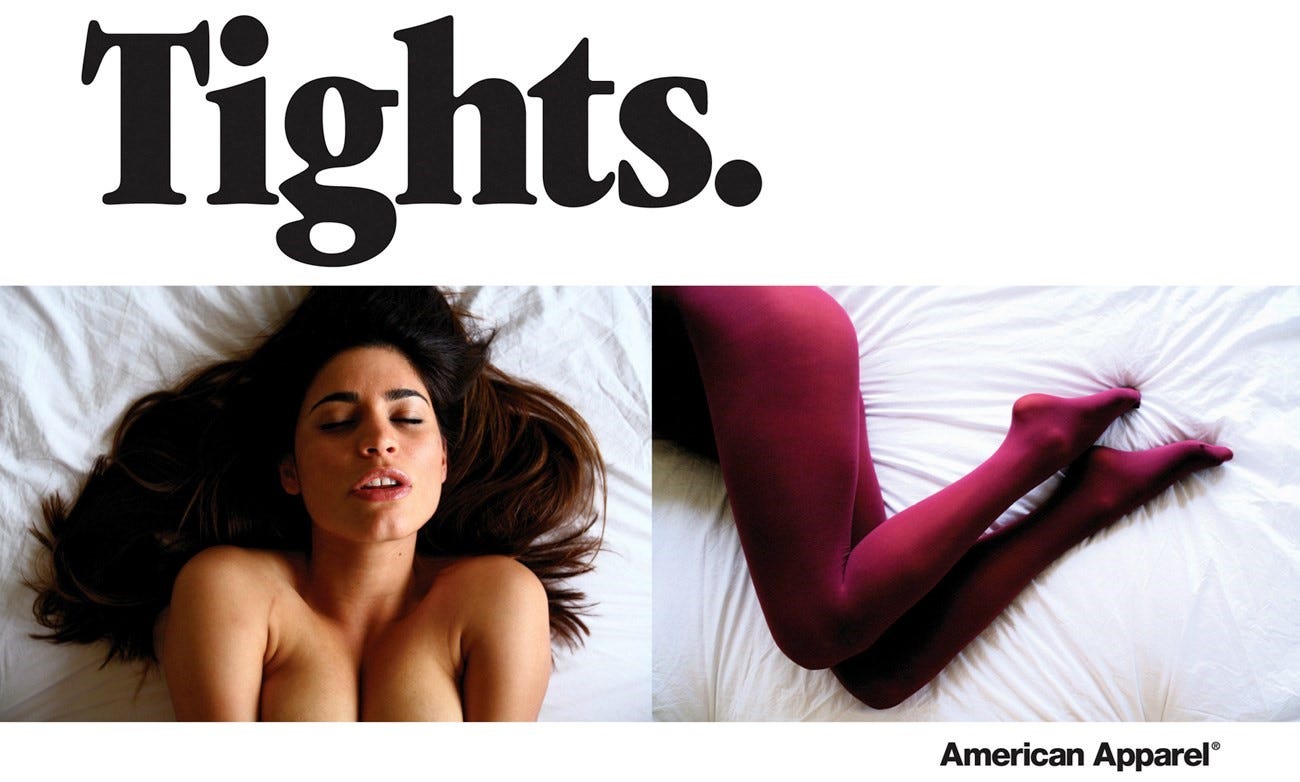
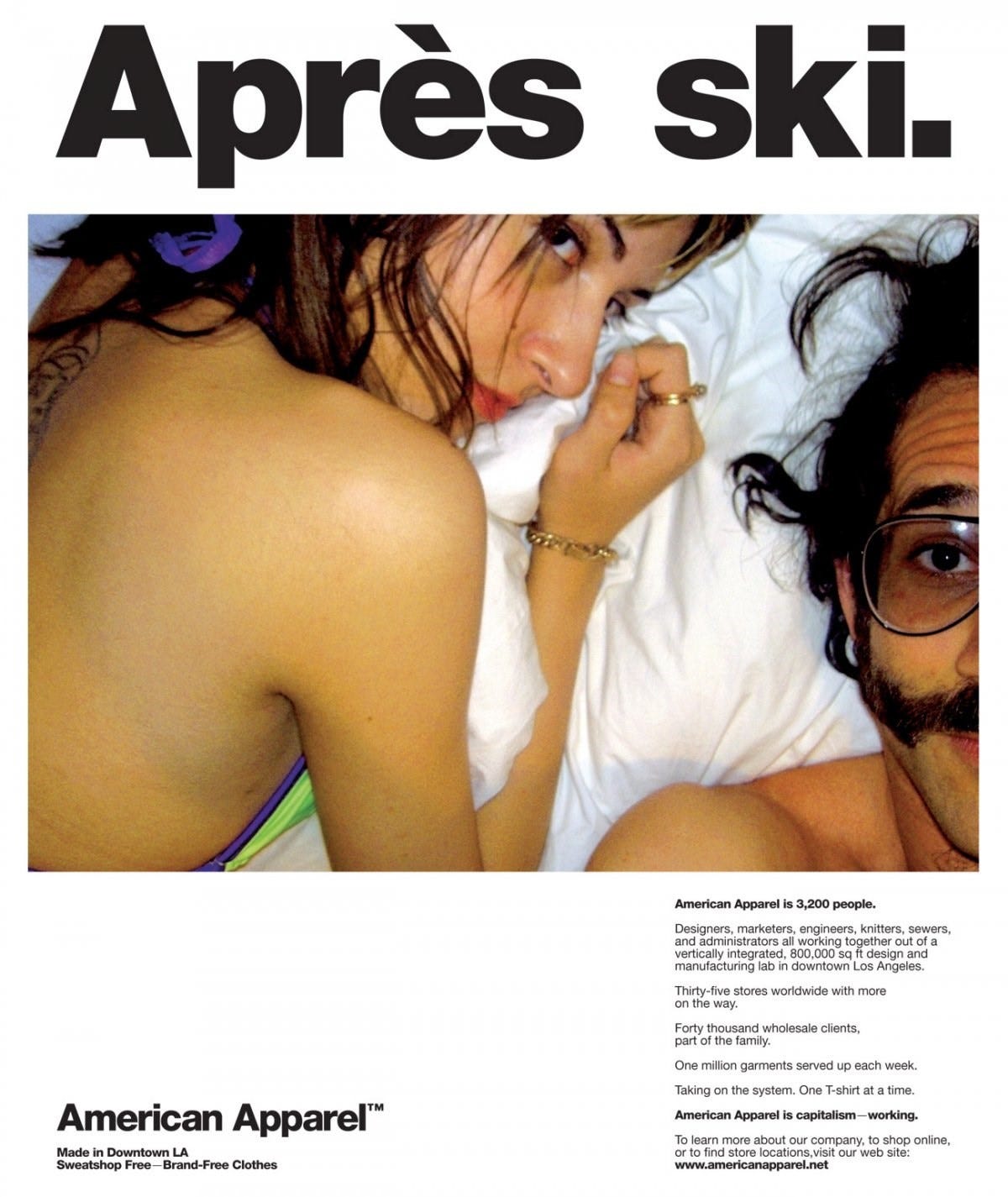
Chapter Eight: The Revival
We’ve already discussed how the indie sleaze phenomenon emerged as a response to the Great Recession aka a global crisis. Now, what has led to a similar state of distress and hopelessness in recent years? You can choose, really. Lately, we’ve faced numerous worldwide crises that would lead anyone to yearn for an escape from reality – be it a pandemic, war, climate change, or the emergence of yet another recession. Unfortunately, the list seems endless. However, it’s important to clarify that this exploration isn’t meant to be a downer; it’s simply an explanation for why see recurring patterns. In the humble opinion of myself and many others, the current state of the world has led to a similar attitude, where we acknowledge that life is finite and we might as well just make the best of it – only that in today’s world, we call it nihilism.
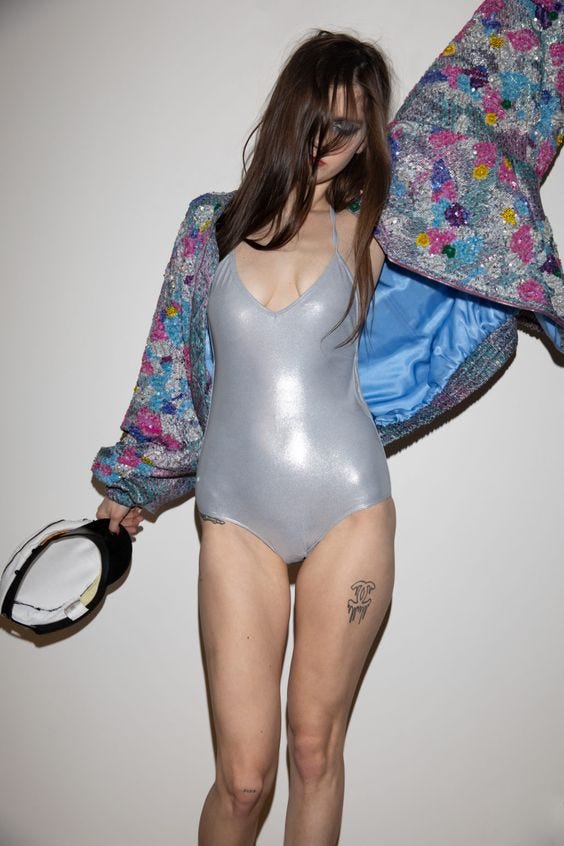
Furthermore, a messy and undone fashion trend serves as the natural follow-up to the whole clean girl aesthetic we’ve been stuck with for a while now. It’s science, you guys! I’ve also seen people compare the gritty influence of Skins to HBO’s Euphoria, which I guess I’d comply with – in parts at least. I think what it really comes down to, is, that we’re already starting to feel a sense of nostalgia for a time that if we’re being honest wasn’t even that long ago. And hey, I’m just as guilty of doing so as the next person. Quite frankly, I’m of the impression that the re-emergence of a messy and fun outlook on life is a good thing – after all, I’m not creating this concerningly long deep dive for nothing
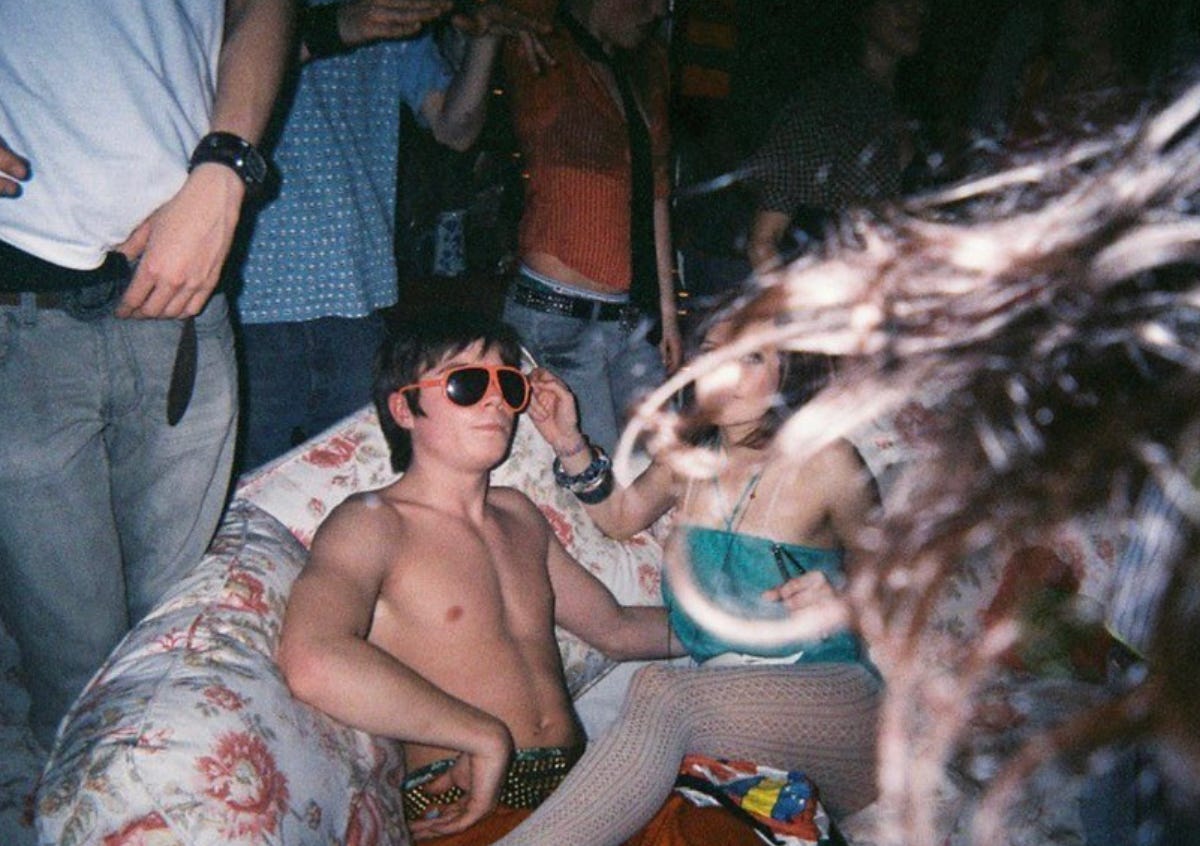
Chapter Nine: The Inspiration
Right, now that we’ve made it to the end of the round (well, almost), you’re probably debating where exactly to take inspiration from in order to really sell the lifestyle – be it in terms of music, fashion or simply the content you consume. Personally, I like to divide the following recommendations into two sections – the first one being “original” media from back then and the second bunch consisting of contemporary things or people merely radiating the same vibe.
In terms of media, I obviously must start out with Skins UK, more specifically Effy Stonem (iykyk!). Don’t be fooled though, I’m aware of the toxicity that was this show. Therefore, this might be a good moment to recommend the podcast “Are you Michelle from Skins?” by April Pearson, who portrayed, you guessed it, Michelle on Skins. She really goes into the unfortunate parts that came with participating in the making of such a graphic series at an early age. Still, the show will forever hold a special (and concerning) place in my heart. Another favourite of mine is Jenny Humphrey’s rebellion arc (and her style) in seasons 2 to 4 of the phenomenon that was Gossip Girl. As far as music goes, I think chapter four offered quite a wide variety of OG recommendations already.
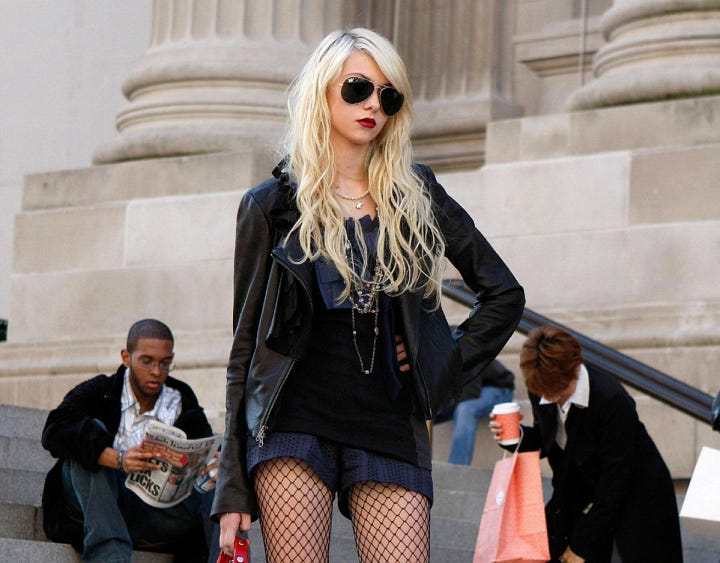
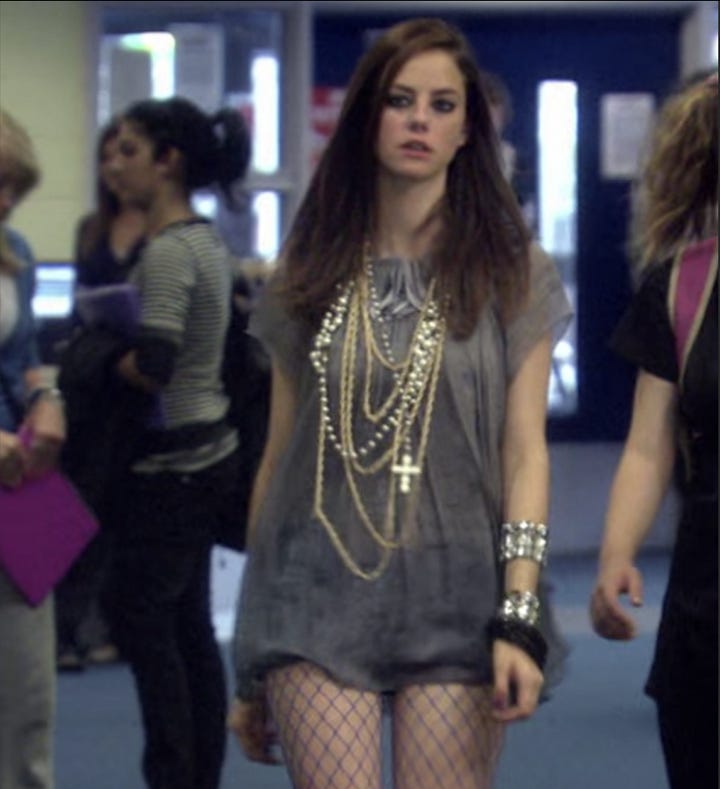
My primary source of content is the account @indiesleaze on Instagram. Trust me when I tell you, that browsing through those pictures will instantly transport you back in time. According to its bio, the account aims to document the decadence of the mid-late aughts – to great success in my opinion. Oh, and did I mention that its owner also hosts a podcast dedicated to the scene and its revival, featuring intriguing guests from that era? By listening to Liv’s podcast “Date with the Night” and following her on Instagram, you’ll never run short of indie sleaze inspo, I promise. Another piece of media I enjoyed was Alexa Chung’s article on the topic written for the Financial Times.
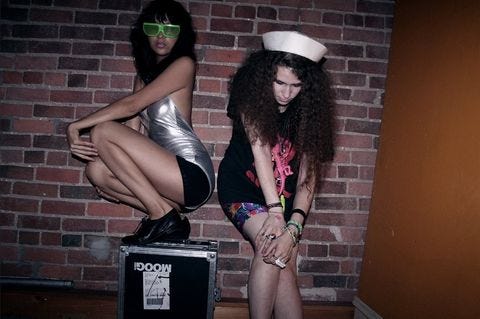
A post shared by @indiesleaze
A contemporary artist from the New York scene who fully embodies the sleazy vibe in both music and appearance is Harrison Patrick Smith aka The Dare. Earlier this year he released his Sex EP and has since been fashioned as the indie sleaze incarnate by all sorts of media outlets. Basically, if you click on a playlist that titles itself “indie sleaze revival” or something, you’ll probably find an electroclash song of his in there. I’m sure there are plenty of other examples out there, but The Dare has been a lot on my radar lately, I suppose.
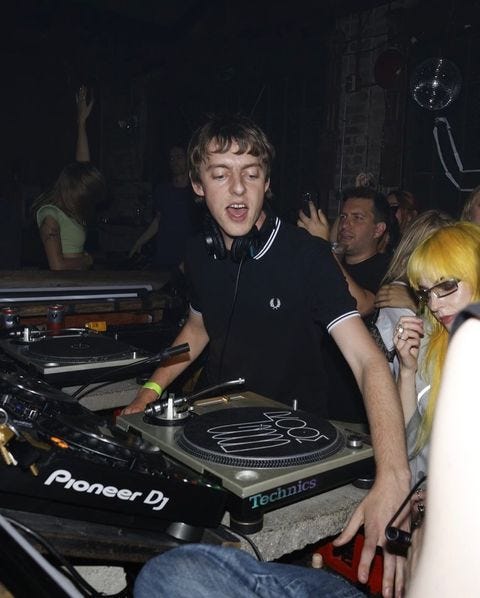
A post shared by @itsthedare
Right, now what is the conclusion, the point I was trying to make? I think it’s clear that I’m quite passionate about everything surrounding this topic. And who could blame me? I mean the photos look fun, don’t they? Let’s be honest, the majority of people currently captivated by the resurgence of indie sleaze aren’t the ones who were able to experience the scene to the fullest in its initial run. I’d argue that most of us are now in our early to mid-twenties – old enough to have witnessed the trend back then but a little too young to have truly lived through it. It evokes a sense of nostalgia and similar to the original era, offers a form of escapism, which I appreciate. In the year 2023, I hereby say: let’s bring indie sleaze back – all while being mindful of its controversial aspects, of course. Though the aesthetic is all fun and games, the last thing we should strive for is a repetition of all the toxic and harmful patterns that came with it the first time around. A little incorporation of its carefree fashion, music and most importantly attitude in today's day and world sounds good to me, however. And with that, I’ll leave you to it. Feel free to check out a playlist (or don’t) and form your own perspective on the matter. My job here is done!
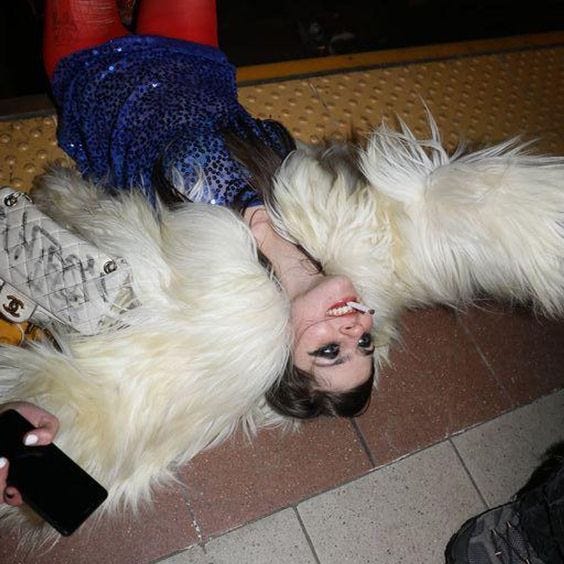
Post a comment